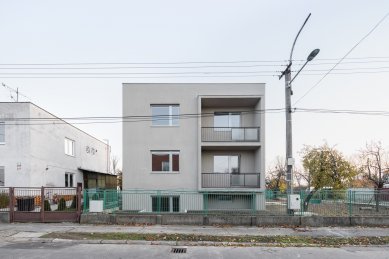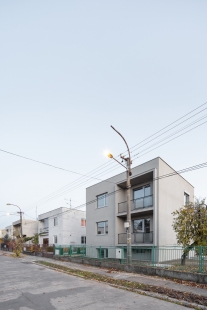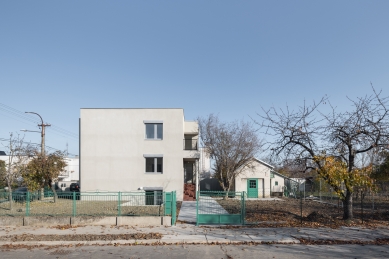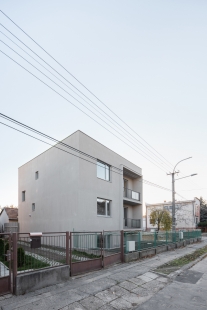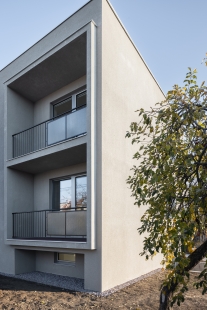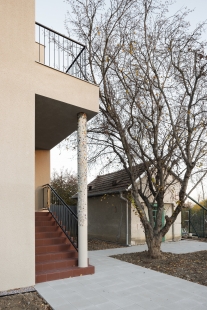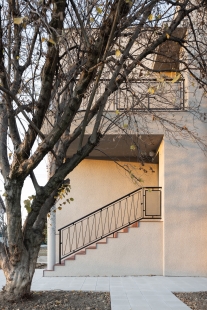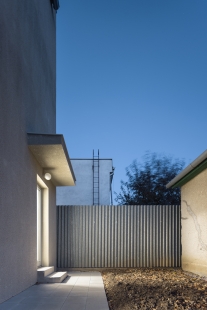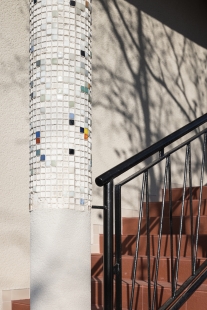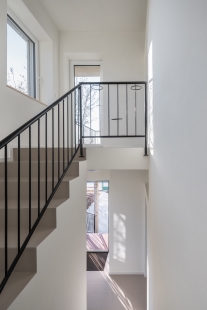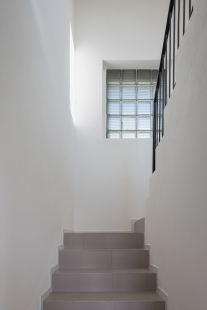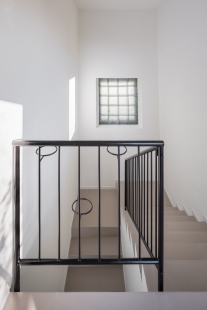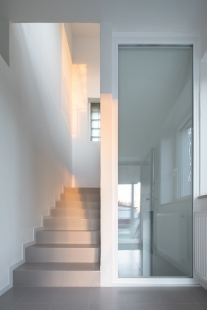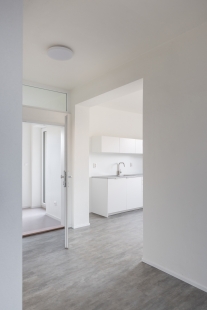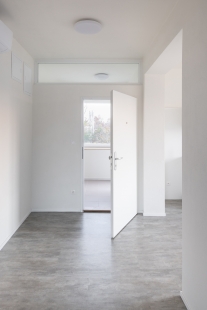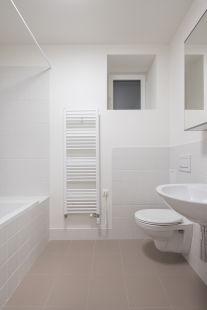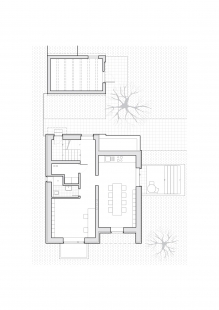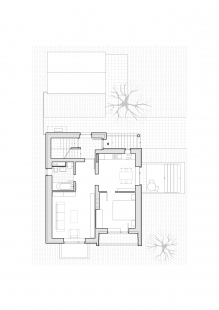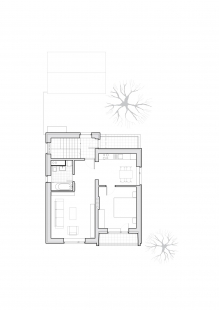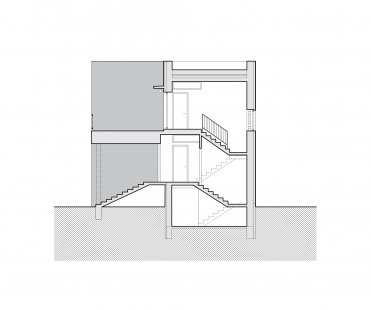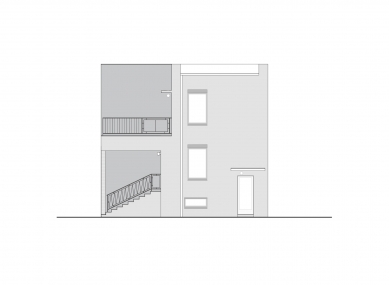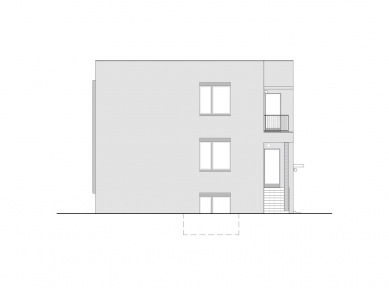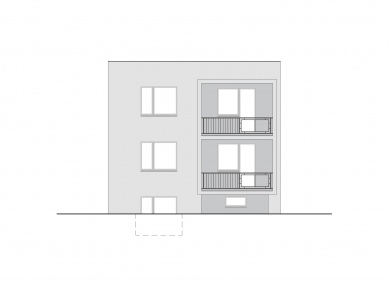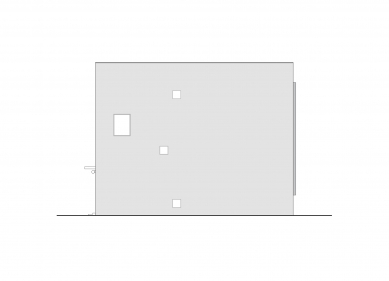
Reconstruction of family house Šaľa

More than a Cube
The development of family houses, that is, the Slovak village still in the first half of the 20th century defined the visual appearance of the Slovak myth, i.e., the idea of Slovakia as a Slavic Tahiti – that mythical land of honest wooden houses, rounded hills, and warm-hearted people. This visuality changed significantly over the course of the 20th century, and the desire for ever-new and ever-"more modern" houses remained with us. What was referred to as a "sober family house" in the seventies and later pejoratively called a "coffee grinder" has meanwhile become part of a visual identity that we once again relinquish in favor of something newer and "different." We are losing something once more, which is why the realization of architect Bakyt, despite its inconspicuousness and low costs, is an architectural achievement!
The conversion of a catalog house in a family development in Šala, possibly due to a small budget, demonstrated how to approach a typical catalog house from the seventies in such a way that not only is its character preserved, but contemporary architecture underlines and highlights what was worth it about the houses, what constituted their architecture. The investor demanded a change from the typical rural cube to a multi-generational house with a separate office unit – essentially three separate units, easily usable in other villages on both sides of the Moravian border.
In his design, the architect adopted a heritage restoration approach – determining which components of the building were characteristic and important to him, which he would honor and emphasize. Another important decision was the intelligent method of insulation and a simple trick to help plastic windows move to a higher aesthetic level. Additionally, he retained all the "ordinary" details such as railings in the house, a mosaic column, and the mass of the staircase. So what exactly did the architect do?
He worked with the existing mass of the house and added nothing; each functional unit was placed on its own floor, utilizing the already existing staircase, which was transformed into a shared one. He retained the risalit on the facade, in which the loggias are placed in their original thickness. The house was insulated, yet all proportional relationships were balanced so that they still felt subtle and referred to the modernist character of the house. This was complemented by a visual lightening of the windows, achieved in two ways. He partially submerged the frame into the facade and used plastic-aluminum windows, which, thanks to two colors of the covering aluminum, do not appear bulky and heavy. As a result, the profiling achieved further accentuated the subtle expression of the window frame and avoided the visual clumsiness typically associated with the use of plastic windows. He prudently decided to invest in the quality of the facade, choosing brizolit in a color of the material that unexpectedly suits the cube. This is also emphasized by the new color of the preserved fence, which is that traditional village style, but suddenly quite different. The composition is completed with minimalist precision by retaining typical period elements, the glass-concrete in the staircase and the mosaic column at the corner of the entrance. He preserved it structurally, repaired and plastered the crumbling base, and fixed the rest; the outcome is unexpectedly impressive, like discovering a shining spot of pure color on an old canvas.
If it seems to us that this is not enough, we can playfully test the correctness. Just take a walk down the street and see how neighboring houses around fare in the test of architecture and time.
Using contemporary terminology, we can speak of conversion, in this case of transforming a dull family house into a multi-unit residence with character. At the same time, we see a case of truly sustainable approach – sensitive not only to resources but also to the character of the existing structure. Last but not least, it is an example of architecture that does not present itself but brings those aforementioned values to the forefront.
The development of family houses, that is, the Slovak village still in the first half of the 20th century defined the visual appearance of the Slovak myth, i.e., the idea of Slovakia as a Slavic Tahiti – that mythical land of honest wooden houses, rounded hills, and warm-hearted people. This visuality changed significantly over the course of the 20th century, and the desire for ever-new and ever-"more modern" houses remained with us. What was referred to as a "sober family house" in the seventies and later pejoratively called a "coffee grinder" has meanwhile become part of a visual identity that we once again relinquish in favor of something newer and "different." We are losing something once more, which is why the realization of architect Bakyt, despite its inconspicuousness and low costs, is an architectural achievement!
The conversion of a catalog house in a family development in Šala, possibly due to a small budget, demonstrated how to approach a typical catalog house from the seventies in such a way that not only is its character preserved, but contemporary architecture underlines and highlights what was worth it about the houses, what constituted their architecture. The investor demanded a change from the typical rural cube to a multi-generational house with a separate office unit – essentially three separate units, easily usable in other villages on both sides of the Moravian border.
In his design, the architect adopted a heritage restoration approach – determining which components of the building were characteristic and important to him, which he would honor and emphasize. Another important decision was the intelligent method of insulation and a simple trick to help plastic windows move to a higher aesthetic level. Additionally, he retained all the "ordinary" details such as railings in the house, a mosaic column, and the mass of the staircase. So what exactly did the architect do?
He worked with the existing mass of the house and added nothing; each functional unit was placed on its own floor, utilizing the already existing staircase, which was transformed into a shared one. He retained the risalit on the facade, in which the loggias are placed in their original thickness. The house was insulated, yet all proportional relationships were balanced so that they still felt subtle and referred to the modernist character of the house. This was complemented by a visual lightening of the windows, achieved in two ways. He partially submerged the frame into the facade and used plastic-aluminum windows, which, thanks to two colors of the covering aluminum, do not appear bulky and heavy. As a result, the profiling achieved further accentuated the subtle expression of the window frame and avoided the visual clumsiness typically associated with the use of plastic windows. He prudently decided to invest in the quality of the facade, choosing brizolit in a color of the material that unexpectedly suits the cube. This is also emphasized by the new color of the preserved fence, which is that traditional village style, but suddenly quite different. The composition is completed with minimalist precision by retaining typical period elements, the glass-concrete in the staircase and the mosaic column at the corner of the entrance. He preserved it structurally, repaired and plastered the crumbling base, and fixed the rest; the outcome is unexpectedly impressive, like discovering a shining spot of pure color on an old canvas.
If it seems to us that this is not enough, we can playfully test the correctness. Just take a walk down the street and see how neighboring houses around fare in the test of architecture and time.
Using contemporary terminology, we can speak of conversion, in this case of transforming a dull family house into a multi-unit residence with character. At the same time, we see a case of truly sustainable approach – sensitive not only to resources but also to the character of the existing structure. Last but not least, it is an example of architecture that does not present itself but brings those aforementioned values to the forefront.
Mária Michalič Kusá & Alexandra Kusá
The English translation is powered by AI tool. Switch to Czech to view the original text source.
0 comments
add comment


